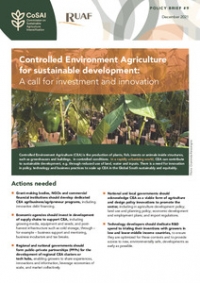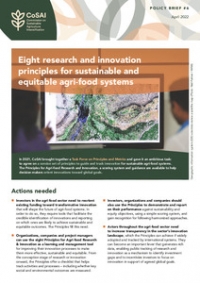This post reviews Agricultural Water Management Journal Special Section: Investing in small, private irrigation to increase production and enhance livelihoods.
It was one of those odd coincidences that I was asked to review the Agricultural Water Management Journal’s Special Section on small-scale private irrigation the same week I set about getting the well on my farm working again. This particular special section (currently open access) is an overview of the thriving but largely overlooked sector of small private irrigation. As a smallholder farmer and science writer/editor, it’s a rare treat to review something I can relate to firsthand experience.
Like most of my neighbors in this remote corner of Northeastern Thailand, I grow one rainfed crop of rice and in the dry season sugar cane and this year peanuts. Sugar cane does well with very little water but peanuts need irrigating, hence getting the well working again. Over the course of the three days I spent wrestling with the well and various small pumps, I couldn’t help but compare my situation with other smallholder farmers who were the focus of the special section papers. But first, my little saga.
Small pump practicum
We stopped using our well two seasons back after a thief (or thieves) removed the copper wire that carried electricity to the 2 HP Chinese electric pump I was using to irrigate the bamboo that we were growing at the time. The same line powered a good quality Hitachi 300 watt shallow well pump on a bore hole at the near end of the field, so the well has been unused for at least of couple of growing seasons.
My first attempt to fix the well was to replace the electric wire and reconnect the pump, but…no water. I noticed hairline cracks on the flange for the intake pipe. Conclusion: the bore hole has silted up from non-use, which means I can try flushing it out or if that fails, drill a new well.
We moved to Plan B. Plan B was to use the 2 HP Chinese pump to pump water from the pond onto the field adjacent. To cut a long story short, I did get it working, but the pressure was too high. You could put this pump on a fire truck. I would have blasted the seedlings right out of the ground. I could have sprayed the entire field. But that’s a horribly inefficient use of water and I couldn’t bring myself to do it. That took all morning. Tomorrow, Plan C.
Plan C was to use a much smaller 1.6 HP submersible pump with a hose attached to fill plastic jerry cans on the far side of the bank which I then used to fill watering cans and walked up and down the rows. This worked and I got a good start on watering those peanuts. Mind you, if I had done that to start with I would have been finished by noon the first day at far less cost and effort.
Back to the special section
Throughout my little adventure, I thought about those papers in the special section. I certainly benefit from the use of small pumps (introductory paper by Charlotte de Fraiture, Meredith Giordano). Without the small submersible pump (Plan C), I would have to run circles around my plot with 10 kg of water in each tank. My knees would never take it.
Already I am thinking about scaling up (Xie et al. 2014) for my peanut operation, for which I probably can use my ‘fire truck’ pump (Plan B); need a lot of pressure to irrigate two or three hectares. I don’t think my little operation is a threat to the environment; there is ample ground water here.
Neither affordability nor access to technology is a problem for me in Northeast Thailand, but it is in sub-Saharan Africa. Namara et al. (2014) propose several measures to address the constraints to uptake of small motorized pumps to fulfill the demand for irrigated cash crops in the dry season, and emphasize interventions along the entire value chain, varying from information supply, training, and access to finance.
Trade policies, taxes and duties don’t really have much affect on the availability or price of pumps and irrigation equipment in Thailand (since there is a wide selection of equipment manufactured in Thailand). But they do affect the availability and price of irrigation equipment in many sub-Saharan African countries including Zambia (Colenbrander and van Koppen, 2012), Ghana (Namara et al., 2014) and Ethiopia (Gebregziabher, 2012).
Policies outside the water sector could affect me, as they often affect the uptake of irrigation technologies. For example, in West Bengal, unfavorable energy policies hinder the electrification of privately owned tubewells. Diesel prices are rising and electricity restrictions constrain smallholder profit margins and have slowed agricultural growth (Mukherji et al., 2009). A lot of farmers in my area of Northeast Thailand are switching to Eucalyptus, cassava, rubber and sugar cane because those crops are less work. But, all except for sugar cane draw a lot of water and could have a cumulative impact on the groundwater supply.
Credit is no problem for me; Thailand’s government agricultural bank has been very progressive and all but the very poorest farmers can get credit. But in Madhya Pradesh, India, despite positive financial returns, many smallholder farmers cannot access the necessary credit to construct rainwater harvesting structures on their own fields (Malik et al., 2014). Changes in policies and regulations governing access to agricultural credit will enable many more smallholders to benefit from the structures like they do in Thailand.
A final reflection
No mistaking that I have so many more advantages than the smallholder farmers who are the focus of the special section. But then, I am not really a farmer. Few real farmers are as clumsy or as mechanically challenged as I am, and few can afford to spend three days basically playing around. If my peanut crop fails it will cause me no real hardship. Not so for the thousands of smallholder farmers who were the subject of the AgWater Solutions research. If you are working with real farmers, I strongly encourage you to delve into the special section on small private irrigation for a feast of insights.
Now then, back to that well.
Download Articles from the Special Section here:
Small Private Irrigation: A thriving but overlooked sector by de Fraiture and Giordano
Small private irrigation: Enhancing benefits and managing trade-offs by Giordano and de Fraiture
Estimating the potential for expanding smallholder irrigation in Sub-Saharan Africa by Xie et al.
Adoption patterns and constraints pertaining to small-scale water lifting technologies by Namara et al.
Examining farm-level perceptions, costs, and benfits of small water harvesting structures in Dewas, Madhya Pradesh by Malik et al.
Pirates or pioneers? Unplanned irrigation around small reservoirs in Burkina Faso by de Fraiture et al.
Agricultural Water Management Journal Special Section: Investing in small, private irrigation to increase production and enhance livelihoods provides an overview of the thriving but largely overlooked sector of small private irrigation. Reporting on case studies from India and sub-Saharan Africa, the authors highlight many facets of the sector in several geographic settings. The introductory paper by Charlotte de Fraiture and Meredith Giordano establishes the importance of the sector in terms of area and numbers of beneficiaries, in comparison with the public irrigation sector. Private irrigation has become so large in scale and scope that it is difficult to understand how policy makers can ignore it. de Fraiture and Giordano describe the sector's main features and challenges for local and national economies, its impacts on the environment, and implications for gender and equity. The subsequent papers further examine the small private irrigation phenomenon in South Asia and sub-Saharan Africa. Authors provide empirical observations and new insights that will be essential for anyone wanting a better understanding of the sector.















Comments
Great article. It's always nice when you can not only be informed, but also entertained!
Thanks for your post. I feel bad that you have had so much trouble with your bore and pump. I think I'm even more surprised that you stopped using it, even thought your wires were stolen, since it is probably the easiest way to water your crops. Would it have really been that difficult to flush out the silted over pipes? https://www.waboreservices.com.au
I thought it was interesting that a well could silt up and become unusable. What causes the silting? Is there a way to not use a well for a time and still have it be usable? I would like to put a well on my property just for emergencies, not general use. Any suggestions? https://store.waterpumpsupply.com/agpu1.html